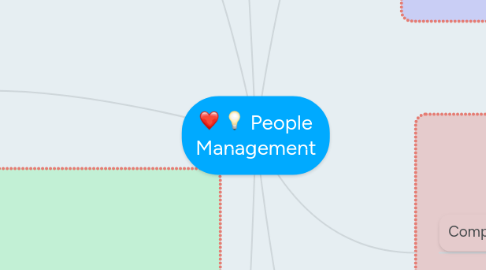
1. Training and Development
1.1. Training
1.1.1. The Five step Training Process
1.1.1.1. Step 1: Needs Analysis Step 2: Instructional Design Step 3: Validation Step 4: Implementation Step 5: Evaluation and Follow-up
1.2. Development
2. Recruitment, Selection, and Placement
2.1. Process of Employee Selection
2.1.1. 1. Application
2.1.2. 2. Assessment
2.1.3. 3. Interview
2.1.4. 4. Selection
2.2. Methods of Recruitment
2.2.1. Contingent Personnel
2.2.1.1. Sources
2.2.1.1.1. Labor Lessor
2.2.1.1.2. Temporary employment agencies
2.2.1.1.3. Independent contractors
2.2.2. External Recruitment
2.2.2.1. Methods of External
2.2.2.1.1. On Line
2.2.2.1.2. Employee referrals
2.2.2.1.3. Applicant-initiated recruitment
2.2.2.1.4. Help wanted advertisement
2.2.2.1.5. Campus recruiting
2.2.2.1.6. Executive search firms
2.2.2.1.7. Private employment agencies
2.2.2.1.8. Public employment agencies
2.2.3. Internal Recruitment
2.2.3.1. Methods of Internal
2.2.3.1.1. Computerized Career Progression System
2.2.3.1.2. Supervisor recommendatuions
2.2.3.1.3. Job Posting
2.2.3.1.4. Career development system
3. Job Organization and Information
3.1. Nature of job analysis
3.1.1. Job Analysis
3.1.2. Job Description
3.1.3. Job Specifications
3.2. Methods of Collecting Job Analysis Information
3.2.1. Interview
3.2.2. Observation
3.2.3. Questionnaire
3.2.4. Participants Diary
4. Labor-Management Relations
4.1. Trade Union
4.1.1. Objectives of a Trade Union
4.1.1.1. Collective bargaining
4.1.1.2. Safeguard jobs
4.1.1.3. Cooperate with employers
4.1.1.4. Political activities
4.1.1.5. Social activities
5. Compensation and Benefit
5.1. Compensation
5.1.1. Employee responses to Under Reward
5.1.2. Employee responses to Over Reward
5.1.3. Equity
5.2. Benefits
5.2.1. Skill Based Pay Plans
5.2.2. Mandatory Employees Benefits
5.2.3. Flexible Benefit Plans
6. Performance Appraisal and Career Management
6.1. Step in Appraising Performance
6.1.1. 1. Define the job
6.1.2. 2.Appraise performance
6.1.3. 3.Provide feedback
6.2. Designing the Appraisal Tool
6.2.1. Graphic rating scales
6.2.2. Alternation ranking
6.2.3. Paired comparison
6.2.4. Forced distribution
6.2.5. Critical incident
6.2.6. Narrative form
6.2.7. Behavioral anchored rating scale
6.3. Performance Appraisal
6.3.1. Supervisor
6.4. Performance Management
6.4.1. HR Department
6.5. An effective performance management process
6.5.1. Direction sharing Role clarification Goal setting and planning Goal alignment Developmental goal setting Ongoing performance monitoring
7. HR Management
7.1. Process and activities
7.1.1. Develop HR plans and job descriptions
7.1.2. Recruit candidates
7.1.3. Interview and select employees
7.1.4. Train employees based on job requirements
7.1.5. Appraise employees
7.1.6. Reward employees

